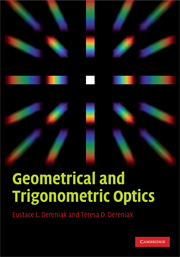Book contents
- Frontmatter
- Contents
- Preface
- 1 Light propagation
- 2 Reflections and refractions at optical surfaces
- 3 Image formation
- 4 Mirrors and prisms
- 5 Curved optical surfaces
- 6 Thin lenses
- 7 Thick lenses
- 8 Mirrors
- 9 Optical apertures
- 10 Paraxial ray tracing
- 11 Aberrations in optical systems
- 12 Real ray tracing
- Appendix A Linear prism dispersion design
- Appendix B Linear mixing model
- Appendix C Nature's optical phenomena
- Appendix D Nomenclature for equations
- Appendix E Fundamental physical constants and trigonometric identities
- Glossary
- Index
- References
1 - Light propagation
Published online by Cambridge University Press: 06 July 2010
- Frontmatter
- Contents
- Preface
- 1 Light propagation
- 2 Reflections and refractions at optical surfaces
- 3 Image formation
- 4 Mirrors and prisms
- 5 Curved optical surfaces
- 6 Thin lenses
- 7 Thick lenses
- 8 Mirrors
- 9 Optical apertures
- 10 Paraxial ray tracing
- 11 Aberrations in optical systems
- 12 Real ray tracing
- Appendix A Linear prism dispersion design
- Appendix B Linear mixing model
- Appendix C Nature's optical phenomena
- Appendix D Nomenclature for equations
- Appendix E Fundamental physical constants and trigonometric identities
- Glossary
- Index
- References
Summary
Background history
The history of optics is filled with examples of unique uses and situations that are beyond the scope of this book which is intended for the student on a first year optics course. However, a brief review is necessary to show how man has been trying to understand and describe light over the last 2500 years.
The word “optics” originated in a book on visual perception written by Euclid some 2000 years ago. Euclid developed geometrical theories to account for the observation of images by mirrors. Some names that come to mind in the history of optics are Ptolemy, Bacon, Brahe, Kepler, and more recently Newton, Huygens, Fermat, Young, and Einstein.
There is a story by Archimedes (212 bc) that the Greeks defended Syracuse (in modern-day Sicily) from the Roman fleet by reflecting sunlight with the soldiers' shields and burning the ships' sails by focusing the intense heat of the Sun's rays.
Muslims in the thirteenth century were purported to have the ability to create a burning mirror to use for burning cities (in the Holy Land). Roger Bacon, a monk under Pope Clement IV, was motivated by this threat to study optics as a weapon of war. He developed similar devices for the Christian crusaders battling the Muslims.
Ptolemy of Alexandria, a Greek from Egypt (about ad 190), knew that two transparent substances, glass and water, had indices of refraction of 3/2 and 4/3, respectively.
- Type
- Chapter
- Information
- Geometrical and Trigonometric Optics , pp. 1 - 29Publisher: Cambridge University PressPrint publication year: 2008



